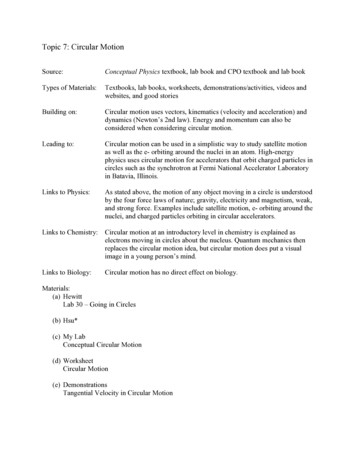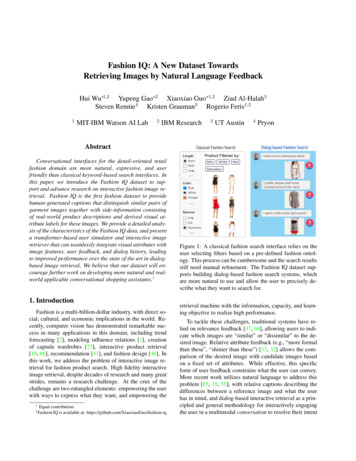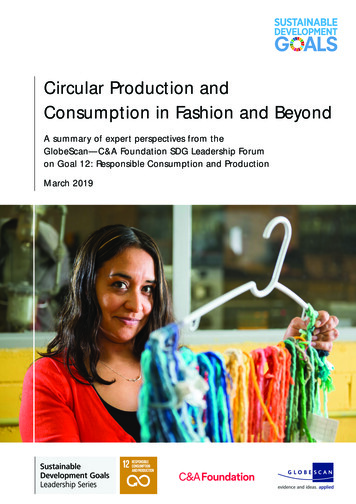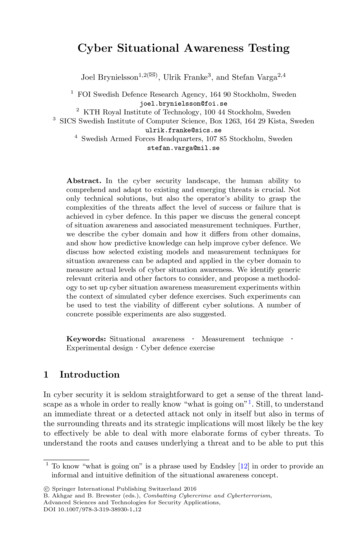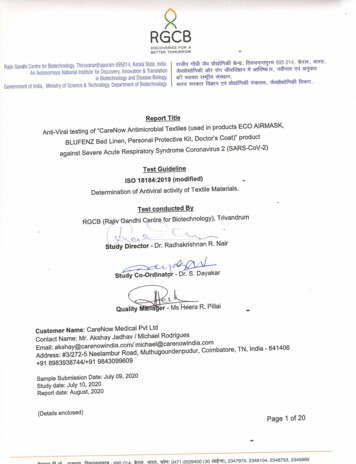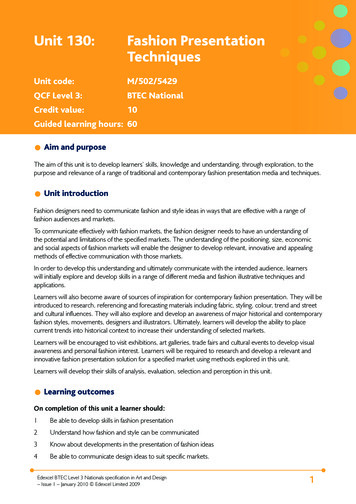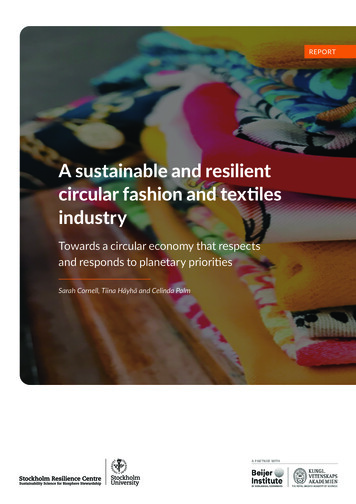
Transcription
REPORTA sustainable and resilientcircular fashion and textilesindustryTowards a circular economy that respectsand responds to planetary prioritiesSarah Cornell, Tiina Häyhä and Celinda PalmA PARTN ER WITH
A SUSTAINABLE AND RESILIENT CIRCULAR TEXTILES AND FASHION INDUSTRYLead Authors (in alphabetical order):Sarah CornellTiina HäyhäCelinda PalmWith contributions from:Jacob HilemanIvan KallsteniusPatricia Villarrubia-GomézStockholm Resilience CentreAnd the Ellen MacArthur FoundationThe Sustainable Textiles project was a science-business collaboration. The research was led by the Stockholm ResilienceCentre at Stockholm University, informed by the Ellen MacArthur Foundation’s work, and funded by H&M Group. This report can bedownloaded via .Cover photo and graphics: Celinda PalmSuggested citation: Cornell, Häyhä and Palm. 2021. A sustainable and resilient circular textiles and fashion industry: towards acircular economy that respects and responds to planetary priorities. A Research Report by Stockholm University’s StockholmResilience Centre for the Ellen MacArthur Foundation and H&M Group.DOI: 10.5281/zenodo.4561847Version: 2021-03-312
A SUSTAINABLE AND RESILIENT CIRCULAR TEXTILES AND FASHION INDUSTRYSUMMARYTackling planetary priorities by applying circular economy principles canhelp the fashion and textiles industry to adapt resiliently to today’srapidly changing social and environmental realitiesThe fashion and textiles industry urgentlyneeds to take a planetary perspectiveSix planetary priorities: already acutepressures where today’s trends intensifyglobal risksGlobal apparel production and consumption are enjoyinga rising trajectory, but too often contribute to negativesocial and environmental impacts. As planetary pressuresmount, the industry is exposed to rising systemic risks.Tackling them requires worldwide action.The fashion and textiles industry plays a vital role inhelping societies to shift from an extractive, wasteful andrisk-multiplying value chain to a circular businessecosystem that can adapt resiliently to today’s realities.Cut carbon emissions to mitigateclimate change and ocean acidificationClimate change alters conditions for all life on Earth. Currentgreenhouse gas levels are unprecedented, and as they rise,climate impacts and risks increase. Cutting carbon emissionsis the only way to stabilize climate.Halt and even reverse the loss of biodiversity,on land and in marine and aquatic environmentsBiological diversity is being lost, reducing nature’s resilience.Maintaining planetary health means protecting andrestoring nature: life below water and life on land,both above and below ground.Tackling planetary pressures with circulareconomy principles is key to promotingsustainability transformationCombining the principles of a restorative and regenerativecircular economy with clear science-based prioritiesderived from the planetary boundaries can create a firmfoundation for a sustainable fashion and textiles system. Circular economy aims to be regenerative – planetaryboundaries explain what needs to be regenerated Circular economy calls for ‘closing the loop’ of linearvalue chains – planetary boundaries indicate whatchanges are needed and how efforts add up Circular economy means rethinking of waste asresources – planetary boundaries track Earth’scapacity to provide natural resources and absorb wasteand pollution.Minimize land use change, especially whereforests are converted to croplandLand use affects climate and biodiversity, but land demandfor fuels, fibres and food is rising. Tackling deforestation is apowerful response to current planetary pressures, buteffective efforts should also tackle land degradation andpoor land management.Rapidly improve nutrient use efficiency in natural fibreproduction, to rebalance global N&P cyclesNitrogen and phosphorus flows alter the nutrient balance ofsoils and aquatic systems. N&P fertilisers are vital for cropproduction, but their harms are globally widespread.Efficient nutrient use is needed.Circular economy is a strategic responseto planetary pressuresMinimize the environmental release ofharmful chemical substancesChemical pollution of land, air and water is a major threatto living beings. Long-lived and bioaccumulating substancesare of particular global concern. Efforts are needed toprevent their release.The fashion and textiles industry already takes action onseveral sustainability challenges – but efforts are oftenpiecemeal. Strategic science-based coordination of actionfor circularity can cover all planetary priorities and helpprevent efforts in one area undermining progress on theothers. Climate change and biodiversity together definethe Earth system conditions that need maintaining. Landand water use, nutrient and pollutant flows are the maindrivers of Earth system change, and their interactionsintroduce unprecedented threats.Use freshwater wisely, without depletingor polluting freshwater resourcesWater is vital for life, and is under increasing pressure frompollution, overuse and climate change. Water conservationmatters, even in areas where water is plentiful. Effectiveefforts focus on freshwater habitats and their surroundinglandscapes.3
A SUSTAINABLE AND RESILIENT CIRCULAR TEXTILES AND FASHION INDUSTRYSustainable business action targets can contribute to resilient system-change goalsBy setting action targets on the planetary priorities now, individual businesses can ensure their circulareconomy efforts reduce pressures by 2030, and also contribute to the system-wide change across the industrythat is needed to meet global goals for the longer term.Decrease CO2 emissions by 8% or more per year from 2020, aiming for carbon neutrality by 2050This ambitious decarbonization target is vital for reaching net-zero emissions. Science-Based Targets specify how abrand’s activities contribute to rapid emissions reductions. Coalitions like EP100 and RE100 enable best-practicesharing and industry-wide learning for transformational action in energy systems.Ensure no net loss of land and marine habitats, aiming for 30% of the world under conservation protection.Brands need to ramp up ecosystem restoration and conservation efforts fast, halting and reversing the long-termdecline of biodiversity losses, while safeguarding human rights. New Science-Based Targets for nature enablebrands to assess their own impact on nature and also to contribute together to achieving global biodiversity goals.Halt deforestation and triple the contribution of climate-smart agriculture to material production, aimingto restore 20% of the world’s land area to a well-functioning, climate-stabilizing, ecologically resilient state.Efficient and resilient agriculture systems, zero deforestation and more reforestation are all needed if global landuse systems are to support the world’s needs for bioresources, food and water and meet net-zero climate and netpositive biodiversity goals. The Bonn Challenge mobilizes global efforts for landscape restoration.Reduce freshwater abstraction and consumptive use by 30%, aiming to maintain total freshwaterwithdrawals below 40% of renewable supplies in all watersheds.This target reduces direct water security risks to brands and recognises the shared nature of water. Given the vitalrole of water for all life, stronger methodologies are currently being developed for contextual sustainability metricsthat help protect the environmental water flows that sustain resilient landscapes. Brands should be responsive tothese developments, and also monitor the ‘water footprints’ of their products.Prevent all release of chemicals of high concern. Reduce use of pesticides by 50%. Reduce waste generationthrough prevention, recycling and reuse, aiming for fully circular and restorative production systems.Countries have failed to meet SDG Target 12.4 on environmentally sound management of chemicals and wastes.Ensuring that circular economy contributes to global sustainability entails urgently preventing the release ofpollution and waste into the environment, bringing transparency all along the value chain, and using best practicesfor hazardous chemicals (e.g., REACH).Prevent nitrogen and phosphorus releases by ensuring full compliance with national air and water qualitycriteria along the supply chain, aiming to improve long-term full-chain nutrient use efficiency by 50%.Global problems with nutrient element flows (N&P) are worsening faster than scientific assessment can keep up,and SDG Targets for good air and water quality by 2020 have not been met. Brands can take action now byensuring that local air and water quality targets are met along the supply chain. Future science-based targets willcover N&P.4
A SUSTAINABLE AND RESILIENT CIRCULAR TEXTILES AND FASHION INDUSTRYContentsTowards a sustainable circular economy7Planetary priorities for the fashion and textiles industry8Why does business need to take a planetary perspective?8What is the state of the planet now?11What are the planetary priorities for business action?13Industry-wide change is needed to tackle pressures on the planet16The fashion and textiles industry is a fast-growing complex system17Problem dynamics lead to rising planetary pressures18Challenging prospects lie ahead19A circular economy can help reduce planetary pressures24Circular economy and planetary boundaries are mutually supportive frameworks24Closing a loop or (re)connecting global ecosystems?27What does this mean for the fashion and textiles industry?30A planet-aware framework for business action towards circular economy30Taking positive action steps36APPENDICES39A.Our social-ecological systems approach: central concepts and methods39B.How are the Planetary Boundaries measured – and how do these scientific measures relate to business?415
A SUSTAINABLE AND RESILIENT CIRCULAR TEXTILES AND FASHION INDUSTRYFigures1.The planetary boundaries framework shows current Earth system changes away from Holocene-like conditions . 72.The business ecosystem is a complex web of organisations whose interactions affect Earth’s biosphere at all scales . 93.The fashion and textiles industry already takes action on several sustainability challenges. 134.The fashion and textiles industry in numbers . 175.The shift to circularity involves tackling problematic self-reinforcing dynamics. 186.Today’s corporate sustainability efforts are cross-linked with the planetary priorities. 197.Synthetic and natural fibres have different patterns of impacts on planetary pressures. 208.Circular economy can reduce planetary pressures by changing resource consumption and use. 249.Business plays a central role in interactions between Earth’s natural resources and worldwide value networks. 2710. Responding to planetary pressures requires an extended scope of action. 2811. Planet-aware business action for a sustainable and resilient circular economy. 3012. Business action targets and system-wide goals. 3913. The adaptive cycle represents a system’s processes of self-organisation and evolution. 4014. Elinor Ostrom's general framework for analysing sustainability of social-ecological systems. 41Tables1.The planetary boundary processes are urgent global and transboundary policy issues. . 102.The industry’s contributions to planetary pressures. 183.Comparing conventional cotton production and cotton standards on the planetary priorities. . 214.Effects of cotton and synthetic fibre production on the planetary priorities . 235.The Action Hierarchy aligns with circular economy principles. . 366.Measurement, monitoring and reporting tools already exist to track progress . 37Useful links What is a circular economy? economy/concept Future Earth, the international research network for global sustainability https://futureearth.org The Global Commons Alliance, ‘A big plan for a small planet’ http://globalcommonsalliance.org6
A SUSTAINABLE AND RESILIENT CIRCULAR TEXTILES AND FASHION INDUSTRYTowards a Sustainable Circular EconomyThe world’s current production and consumption systems are pushing farbeyond the planetary boundaries. Earth’s ‘safe operating space’ isshrinking. Action is neededGlobal apparel consumption is on a rising trajectory, and it isprojected to continue to increase rapidly in the coming decadeand beyond. This accelerating pace of production andconsumption is leading to worsening negative social andenvironmental impacts. As a result, the fashion and textilesindustry is already operating under consumer scrutiny andtightening policy constraints, and can no longer continue withbusiness as usual. Circular economy is an emerging approachto drive economic development decoupled from resourceconsumption, which benefits society and regenerates theenvironment.Achieving a sustainable and circular fashion and textilessystem hinges on concerted action across society, involvingother industries, policy-makers and (not least) the millions ofpeople who buy and enjoy fashion. The United Nations2030 Agenda for Sustainable Development emphasises theurgent need for action, and it recognises that planet-scalechanges now place pressing constraints on development anddrive rising risks to future prosperity. The planetaryboundaries framework1 for global sustainability describesthe large-scale, long-term environmental conditions on Earththat have maintained a ‘safe operating space’ for humanity –but this planetary stability is increasingly under pressurebecause of the activities of the world’s societies.Throughout this report, we link circular economy principleswith the planetary boundaries framework, helping to setbusiness decision making within its globally interconnectedsocial and environmental context. We describe how theplanetary boundaries can be translated to baselines of globalresponsibility for resource use and negative externalities. Weoutline the planetary priorities for setting science basedtargets at the necessary level of ambition to steer and trackbusiness action that reduces the pressures on Earth’s safeoperating space.In short, we show how applying circular economy principlescan help societies shift from an extractive, wasteful and riskmultiplying value chain to a circular business ecosystem for afashion and textiles industry that can adapt resiliently totoday’s environmental realities.The planetary boundaries framework (Figure 1) shows how human activitieshave shifted Earth’s natural processes away from the 10 000-year stablebaseline of the Holocene epoch2. This is a relatively short window in geologicaltime, but it is an important timeframe because Earth’s climate and living naturehave been relatively stable, allowing for today’s societies to establish and thrive.The further the world goes beyond this ‘safe operating space’, the higher therisks of disruptive environmental change. Some processes in the frameworkare already acutely under pressure, and current production and consumptiontrends are making the problems worse. A focus on these processes definesscience based priorities for global responsibility on resource use and environmental harms.Circular economy provides actionable principles for economic development thatbenefits society and works in harmony with the living environment. A circulareconomy regenerates natural systems, keeps products and materials in use, anddesigns out waste and pollution. Combining circular economy principles with thepriorities flagged in the planetary boundaries framework can create a firmfoundation for a restorative and regenerative fashion and textiles system.12J Rockström and colleagues 2009. A safe operating space forhumanity. Nature 461: 472–475. https://doi.org/10.1038/461472aLoss ofbiosphereintegrityRISING RISKSPlanetary boundaries and circular economy – key concepts for a sustainable futureClimatechangeChemicalpollutionand othernovel anacidificationFigure 1 – The planetary boundaries framework shows currentEarth system changes away from Holocene-like conditionsW Steffen and colleagues 2015. Planetary boundaries: guidinghuman development on a changing planet. Science 347: 12598557
A SUSTAINABLE AND RESILIENT CIRCULAR TEXTILES AND FASHION INDUSTRYPlanetary priorities for thefashion and textiles industryToday’s ‘take-make-use-waste’ value chains are not resilient and arerisk multipliers on all the planetary priorities. System change is neededWhy does business need to take a planetary perspective?The planet’s ‘safe operating space’ is underpressureMuch of today’s global economy is a bio-based economy,dependent on the continued production and trade of Earth’sliving resources for food, fodder, feedstocks, fibre and fuel.Yet the scientific community has warned that the global scaleand accelerating rates of human-driven changes arefundamentally altering the ways that our living planetfunctions. Future resource flows will be affected byenvironmental changes and by increasing climate variability.Productive areas will shift, changing the political context oftrade. In this context, societies worldwide are mobilizing for‘cleaner and greener’ goods, environmental change hasbecome an international political priority, and the textilefashion industry is in the spotlight.The situation is growing urgent. In 2015, the world’snations agreed on 17 Sustainable Development Goals. Theseglobal goals press for concerted action on climate change,biodiversity loss and environmental protection in line withinternational agreements, as well tackling many otherunwanted and unsustainable impacts associated with today’sproduction and consumption systems. Yet by 2020, progressremains uneven and the world is not on track to meet theSDGs by 20303.Business plays a major role in the global response to theseplanetary changes. The timescales that matter most to thebusiness world are typically very short, when set against thelong-term dynamics of global environmental changes. But nowthat the pressures on planetary processes are high and risksare rising, the quarterly and annual planning cycles of businessare vital parts of society’s ability to adapt responsively tochanges and avoid the worst risks. It is time for businesses totake Earth’s large-scale and long-term system conditions intoaccount in their decision-making for sustainability andresilience.The planetary boundaries framework highlights the rising risksof systemic environmental change. It consists of a globalstatus-check on nine environmental change processes wherehuman activities are driving the Earth outside of thecomparatively stable and predictable biophysical conditionsseen over the past 10 000 years. These processes interact,altering the functioning of the whole Earth system withimplications for the worldwide resilience of today’s societiesand globalised economies. When the global status-check iscombined with information about current trends in humancaused pressures, the planetary boundaries framework can beseen as a dashboard of red-alert messages about changes tothe long-term state of the global environment.The quantifications of the framework’s nine processesdraw upon worldwide scientific efforts, including the periodicassessments of global change made by international sciencepolicy forums such as the IPCC and IPBES.4 Much of thescientific evidence base for the framework is maintained bythe global research projects of the international sciencestrategy network Future Earth5. The framework’s processesare also covered by various international policies, like the ParisAgreement for climate change. Table 1 outlines this scienceand policy context.The science-based, policy-relevant framework provides asystemic basis for responding to the changing dynamics of thewhole Earth, rather than treating environmental changes asseparate reasons for concern. The framework gives afoundation for setting precautionary constraints to minimisethe societal risks of linked global environmental changes.Some important ideas need to be kept in mind when theplanetary boundaries framework is put into practice:3United Nations 2020. The Sustainable Development Goals Report 2020. nable-DevelopmentGoals-Report-2020.pdf4 IPCC is the Intergovernmental Panel on Climate Change, www.ipcc.ch. IPBES is the Intergovernmental Science-Policy Platform on Biodiversity andEcosystem Services, www.ipbes.net5 futureearth.org8
A SUSTAINABLE AND RESILIENT CIRCULAR TEXTILES AND FASHION INDUSTRYneed to act urgently on all the global change issues flagged inthe planetary boundaries framework.The planetary boundaries involve tightly interconnectedEarth system processes, even though the boundaries arequantified separately. As human-caused pressure on oneboundary continues to intensify, the ‘operating space’demarcated by the others will shrink – but in poorlypredictable ways. Researchers are developing nexus methods6that help to analyse and deal with multiple issues at once,such as climate, land use, ecosystem health and waterresources.The planetary boundary processes are global andtransboundary policy issues. Action to reduce pressures onthese processes supports the achievement of the SDGs, aswell as the implementation of many other multilateralenvironmental agreements regionally and globally for ahealthy planet.The boundaries are a large-scale complement to local impactindicators. The framework is not intended to substitute forlocal sustainability efforts. Continued intense pressure on theboundaries will have very different local effects in differentparts of the world, and there are many situations where localaction is needed even if a planetary boundary is not breached(as in the case of freshwater use).The boundaries highlight unsustainable trends whereworldwide action is urgently needed. Even where there maystill be uncertainty about a boundary’s quantification in termsof its Holocene baseline, the problematic trends need to behalted and where possible reversed in order to maintain thestability and resilience of Earth’s living systems. There isalready enough scientific and socioeconomic evidence of theThe global business ecosystem is embedded in theplanetary ecosystemTRADEASSOCIATIONSPOLICY MAKERSMULTISTAKEHOLDERPLATFORMSBusinesses often use the term ‘business ecosystem’ todescribe the complex interactions that form betweenorganisations as they cooperate and compete to deliver ontheir value propositions. In today’s globalised economy, manyof these connections now span the world. The global businessecosystem for sustainable fashion and textiles (FFigure 2)comprises a complex worldwide network of clothing brands,retailers, manufacturers, and trade associations – and alsoadvocacy campaigns, multi-stakeholder platforms, and variousother issue-based organisations.7The challenge businesses now face is to recognize that theyalso operate as ‘organisms’ within the planetary ecosystem,and are subject to influence and constraints from the naturalworld. Business decision-making interacts with biophysical,social, political and technological factors in ways that havecomplex consequences for society and the environment.Because of this it can be helpful to think in terms of the wholeworld as a tightly linked social-ecological system.8 (Read moreabout how we use this systemic approach in Appendix A.)However, businesses mainly think of the businessecosystem in relation to the direct economic partnershipsthey maintain within their own value chains. Each businessoccupies its own niche, naturally focusing most on their directconnections with suppliers and customers, and not alwaysrecognizing the vital contributions of the living world.FASHIONBUSINESSESSOCIAL re 2 – The fashion and textiles industry's business ecosystem is a complex webof organisations13 whose interactions affect Earth’s biosphere at all scalesThis means that even global businesses usually see onlypart of their place in the planetary system. Businesses oftenmap their value chain geographically in terms of the locationsof their production sites, main offices and key customer bases– but businesses also need to recognise that the planetarymap of the true social and ecological impacts of their materialactivity may be very different from these places. Businessactions ripple through the whole system. These interactionsscale up, from business actions to worldwide impacts onsocieties and the natural environment. Interactions also scaledown, as changes in social and environmental contexts andplanetary conditions have impacts on individual businesses.6DL Bijl and colleagues 2018. Unpacking the nexus: Different scalesfor water, food and energy. Global Environmental Change 48: 22-317J Hileman and colleagues 2020. Keystone actors do not act alone.PLOS One 15(10): e02414538F Berkes and colleagues 2002. Navigating Social-Ecological Systems:Building Resilience for Complexity and Change. Cambridge UniversityPress9
A SUSTAINABLE AND RESILIENT CIRCULAR TEXTILES AND FASHION INDUSTRYTable 1 – The planetary boundary processes are urgent global and transboundary policy issues. Scientific consensus about theirimportance is strong, and international science-policy forums support measurement and monitoring of global changes. Businessaction is needed to tackle these issues. It can also help make companies more policy-compliant and prepared for future changes.Global scientific assessmentsMultilateral policy agreements andsupporting science-policy forumsLinks to the 2030 AgendaClimate change and Ocean Acidification‘Warming of the climate system is unequivocal, and since the1950s, many of the observed changes are unprecedented overdecades to millennia’ – IPCC 2013/2014 Synthesis Report (themost recent global assessment).See previous IPCC Assessment Reports and Special Reports:www.ipcc.ch/assessment-reportUN Human Development Reports 2007/2008 and 2014 alsoassess climate and society.‘Ocean acidification will continue for centuries if CO2 emissionscontinue, it will strongly affect marine ecosystems, and theimpact will be exacerbated by rising temperature extremes’– IPCC 2013/2014 Synthesis Report.IPCC Working Group II Assessment Reports assess thephysicochemical state of the world’s oceans. There is nocomprehensive global assessment yet of social and ecologicalimpacts of ocean acidification, but for a useful overview see:www.epoca-project.euThe main international agreement is the UN FrameworkConvention on Climate Change and its 2015 ParisAgreement. The Vienna Convention and its MontrealProtocol control emissions of ozone-depletingsubstances which are also powerful greenhouse gases.The UN Economic Commission for Europe’s Conventionon Long-range Transboundary Air Pollution setsemission targets for short-lived climate pollutants suchas soot, with signatories across most of the northernhemisphere.The main science-policy forums for climate and oceanacidification are the Intergovernmental Panel on ClimateChange (www.ipcc.ch) and the UNFCCC’s SubsidiaryBody for Scientific and Technological ybodies/sbsta).SDGs 13 and 7 aredirectly linked toclimate change andocean acidification.The main agreements are the UN Convention onBiological Diversity, the Convention on InternationalTrade in Endangered Species, and the Ramsar, Bonn andBern Conventions that deal with different aspects ofnature conservation and sustainable use.For more information see www.cbd.int/ecolex.The main forums are the Intergovernmental SciencePolicy Platform on Biodiversity and Ecosystem Services(https://ipbes.net), and the CBD’s Subsidiary Body onScientific, Technical and Technological Advice(www.cbd.int/sbstta).SDGs 14 and 15 aredirectly linked tobiodiversity loss andecosystem change.The main agreements dealing wit
A sustainable and resilient circular fashion and textiles industry Sarah Cornell, Tiina Häyhä and Celinda Palm Towards a circular economy that respects
